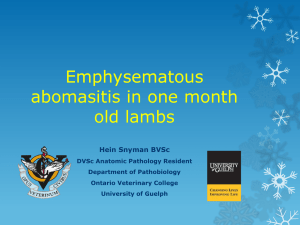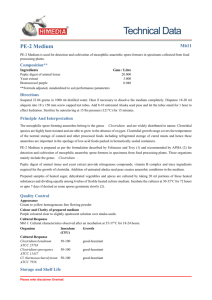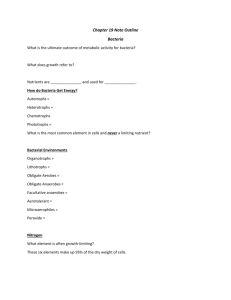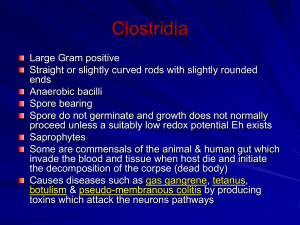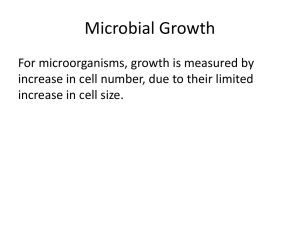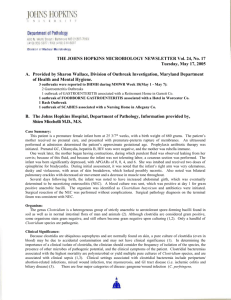this resource 4.63 MB
advertisement
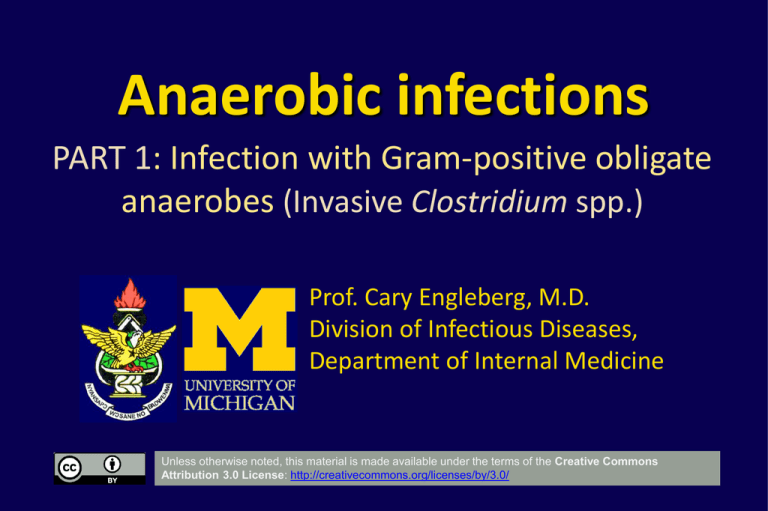
Anaerobic infections
PART 1: Infection with Gram-positive obligate
anaerobes (Invasive Clostridium spp.)
Prof. Cary Engleberg, M.D.
Division of Infectious Diseases,
Department of Internal Medicine
Unless otherwise noted, this material is made available under the terms of the Creative Commons
Attribution 3.0 License: http://creativecommons.org/licenses/by/3.0/
Disclaimers
• I have reviewed this material in accordance with U.S. Copyright Law and have tried to
maximize your ability to use, share, and adapt it. The citation key on the following slide
provides information about how you may share and adapt this material.
• Copyright holders of content included in this material should contact
open.michigan@umich.edu with any questions, corrections, or clarification regarding the use
of content.
• For more information about how to cite these materials visit
http://open.umich.edu/education/about/terms-of-use.
• Any medical information in this material is intended to inform and educate and is not a tool for
self-diagnosis or a replacement for medical evaluation, advice, diagnosis or treatment by a
healthcare professional. Please speak to your physician if you have questions about your
medical condition.
• Viewer discretion is advised: Some medical content is graphic and may not be suitable for all
viewers.
Citation Key
for more information see: http://open.umich.edu/wiki/CitationPolicy
Use + Share + Adapt
{ Content the copyright holder, author, or law permits you to use, share and adapt. }
Public Domain – Government: Works that are produced by the U.S. Government. (17 USC § 105)
Public Domain – Expired: Works that are no longer protected due to an expired copyright term.
Public Domain – Self Dedicated: Works that a copyright holder has dedicated to the public domain.
Creative Commons – Zero Waiver
Creative Commons – Attribution License
Creative Commons – Attribution Share Alike License
Creative Commons – Attribution Noncommercial License
Creative Commons – Attribution Noncommercial Share Alike License
GNU – Free Documentation License
Make Your Own Assessment
{ Content Open.Michigan believes can be used, shared, and adapted because it is ineligible for copyright. }
Public Domain – Ineligible: Works that are ineligible for copyright protection in the U.S. (17 USC § 102(b)) *laws in
your jurisdiction may differ
{ Content Open.Michigan has used under a Fair Use determination. }
Fair Use: Use of works that is determined to be Fair consistent with the U.S. Copyright Act. (17 USC § 107) *laws in your
jurisdiction may differ
Our determination DOES NOT mean that all uses of this 3rd-party content are Fair Uses and we DO NOT guarantee that your
use of the content is Fair.
To use this content you should do your own independent analysis to determine whether or not your use will be Fair.
What is an obligate anaerobe?
• Obligate aerobes
– acquire energy ONLY by respiration
– cannot survive without oxygen
• ex. Mycobacterium tuberculosis, Pseudomonas aeruginosa
• Obligate anaerobes
– acquire energy ONLY by fermentation
– most cannot survive in oxygen
• ex. Clostridium perfringens, Bacteroides fragilis
• Facultative anaerobes (most bacteria)
– acquire energy by either respiration OR fermentation
– Can survive with or without oxygen
• ex. E. coli, Staphylococcus aureus
Where do obligate anaerobes live?
• Endogenous (in the body)
– GI tract of animals
– Gingival crevices around teeth
– Skin glands and hair follicles
• Exogenous (in the environment)
– Soil
The Endogenous Microbiome
• Our bacteria > our own cells
• Roles of endogenous microbiota (microflora)
– Digestion
– Colonization resistance
– Induction of antibodies (IgA, IgG, etc.)
– Normal development of the immune response
• Should the microbiome be considered
another organ of the body?
Sources of Anaerobic Infections
• Usually endogenous
– Intestinal anaerobes
– Oral anaerobes
• Usually exogenous
– Clostridium tetani (tetanus)
– Clostridium botulinum (botulism)
– Clostridium difficile (antibiotic-associated colitis)
• Either endogenous or exogenous
– Other Clostridial infections (e.g., gas gangrene)
What are these lectures about?
• Part 1: Invasive Clostridium spp.
– gas gangrene/myonecrosis
– wound infection/abscess
– food poisoning
C. perfringens, C. septicum,
C. histolyticum, C. novyi, etc.
C. perfringens
• Part 2: Toxigenic Clostridium spp.
– tetanus
– botulism
– antibiotic-associated colitis
C. tetani
C. botulinum
C. difficile
• Part 3: Gram-negative anaerobes
– abscesses
– other
B. fragilis, Bacteroides spp,
Prevotella, Porphyromonas,
Fusobacterium, anaerobic cocci
Case: infected wound
• 46 year old male construction supervisor fell
~4 meters onto an iron reinforcing rod at a
construction site. The rod penetrated the left
upper arm and tore the skin.
• The patient was told that he was diabetic
many years earlier but was on no treatment.
• At the ED, the wound was sutured closed and
bandaged. A pain killer and an oral antibiotic
were prescribed. The patient took the pain
killer only.
Case (continued)
• He returned 48 hours later with extreme pain
and tenderness of the entire left arm
• Temperature=39.5C (fever).
• Thin watery drainage from the wound.
• “Crunchy” sensation under the affected skin
(i.e., crepitus).
• An xray of the shoulder shows gas in the
tissues under the affected skin.
• Routine bacterial culture: negative.
Engelbert Schröpfer, Stephan Rauthe and Thomas Meyer, Wikimedia Commons
Gram-stain of watery discharge
Andreas Zautner, 2006
No intact PMNs were seen
Case (continued)
• The patient was hospitalized urgently and
treated with high-dose penicillin
• He underwent several extensive debridements
of devitalized muscle and skin, followed by
muscle flap and skin graft closure.
• Anaerobic culture at his first surgery grew a
Gram-positive rod with central spores.
Engelbert Schröpfer, Stephan Rauthe and Thomas Meyer, Wikimedia Commons
Questions to consider?
• Where did these bacteria come from? Why
were they at a construction site?
• Why are there no intact PMNs in the pus?
• Why is there gas in the tissue?
• Why was the routine culture negative?
• Why is this infection so aggressive in this
patient?
• Why was it necessary to do repeated surgery if
antibiotics are active?
Clostridium species
• Gram-positive, spore-forming bacilli
• Sporulation occurs in nutrient-limiting conditions
• Spores are resistant to extremes of dryness, heat
(boiling), and many chemical disinfectants
• They can persist in the environment for weeks to
months and germinate deep in the soil where the
conditions are anaerobic
• In favorable conditions (e.g., in human tissues),
spores germinate and may produce toxins
Sporulation
• Complex sequence of gene expression is
triggered
• Asymmetric cell division, with partitioning
of a chromosome into an internal spore
(endospore)
• Elaboration of a thick, impermeable surface
coat
Spores
Cell division
and partitioning
Elaboration of
a spore coat
Free spore
Spore positioning and species
Terminal spore
C. tetani
Central spore
C. perfringens
Subterminal spore C. septicum, novyi, histolyticum
difficile, botulinum
Wounds and soft tissue infection
• C. perfringens type A is the most common invasive
clostridial species (but other species can cause similar
effects – C. novyi, C. septicum)
• The organism requires damaged tissue with anaerobic
conditions, impaired blood supply, complex nutrients,
and Ca++ ions
• Produces 12 toxins that attack membranes, including:
– a-toxin (lecithinase, AKA “myotoxin”)
– zinc metallophospholipase (hydrolyzes phosphatidylcholine
and sphingomyelin-kills cells)
• Toxins destroy PMNs, produce myonecrosis
• Organisms produce gas when they grow = crepitance in
tissue
Management of gas gangrene
• Surgical debridement of all devitalized tissues
(remove the anaerobic/necrotic focus)
• Penicillin and other beta-lactam antibiotics are
effective but not sufficient
• Antitoxins are not effective
• Hyperbaric oxygen may be useful
• There is no vaccine
Clostridia may also be involved in
milder non-necrotizing wound
infections, often in combination
with other pathogens, e.g., diabetic
foot infections, leprous wounds
Laboratory diagnosis
• To cultivate anaerobes, the specimen
should not be exposed to air
Sources undetermined
Anaerobic growth
• Anaerobes will grow at the bottom of tubes
of static nutrient broth
• To separate facultative from obligate
anaerobes you must plate out the growth
from the bottom of the tubes
Thought experiment
Pseudomonas
aeruginosa S. aureus
Clostridium
spp.
Soft agar tubes
Culturing anaerobes on plates
• Media (blood agar) should be pre-reduced
• Swabs should be pre-reduced when used
• Plating and culture is ideally done in an
anaerobic environment
Bob J Galindo, Wikimedia Commons
Tigerweet, Flickr. com
Another thought experiment
Mixture of: Pseudomonas aeruginosa
S. aureus
Clostridium sporogenes
37C x 24h
in air
37C x 24h
in an anaerobic chamber
Most obligate anaerobes
produce a distinctly
unpleasant odor!!
Questions to consider?
• Where did these bacteria come from? Why were
they at a construction site?
• Why are there no intact PMNs in the pus?
• Why is there gas in the tissue?
• Why was the routine culture negative?
• Why is this infection so aggressive in this patient?
• Why was it necessary to do repeated surgery if
antibiotics are active?
Case: Spontaneous gas gangrene
• A 50 year old man developed gas gangrene
of his right shoulder without any
predisposing trauma.
• Culture of the debrided tissues grew C.
septicum
• Two months later, colon cancer was
diagnosed.
Spontaneous C. septicum gangrene
Mandell, G. Essential Atlas of Infectious Diseases
Clostridial diseases in which culture is
not usually done
•
•
•
•
Food poisoning
Tetanus
Botulism
Antibiotic-associated colitis
C. perfringens food poisoning
• Improperly-handled food is contaminated with
spores, which survive cooking temperature
• Spores germinate with heating (anaerobiasis)
and if >105/g bacteria are ingested, illness may
occur
• Sporulation in the small intestine releases
enterotoxin
• Diarrhea (without fever) occurs 6-18 hours
later, and resolves in 1-2 days
Clostridial food poisoning
Spores
Food held too long
at room temperature;
cools slowly; spores
germinate
(Meat or poultry)
Bacteria sporulate
in the small intestine;
release enterotoxin
Diagnosis Management of
Clostridial Food Poisoning
• Usually recognized by multiple cases of diarrhea
6-18 hours after ingestion of food (usually in
restaurants, not home)
• Culture of the patient is not helpful
• Treatment is supportive only (resolves
spontaneously); no antibiotics
• Identify the food vehicle, (culture), and correct
preparation problem
Generalizations about invasive
Clostridium spp.
• Sporulation is critical for survival in the
environment (soil)
• Exogenous infections = spores in wounds;
Endogenous infections = vegetative bacteria
released from colonized sites (e.g., colon)
• Disease is mediated by exotoxin-release from
vegetative cells
• Simple antibiotics are effective, but not in nonviable tissues; surgery is often required
• Antibiotic resistance is not a problem
Summary of Key Points
• Clostridium spp. are Gram-positive spore-forming, obligate anaerobic
bacteria that grow in devitalized tissues.
• Alpha-toxin is a lecithinase that destroy cell membranes, including PMNs
and muscle cells.
• Gas gangrene and myonecrosis may result from wound infection with
certain clostridia
• Antibiotics and surgery are critical if the patient is to survive.
• Clostridia may contribute to lesser, mixed bacterial wound infections
• C. septicum bacteremia may signal colon cancer
• Clostridial enterotoxin causes a self-limited diarrhea (food poisoning) but
is not invasive most cases.
Additional Source Information
for more information see: http://open.umich.edu/wiki/CitationPolicy
Slide 11: Engelbert Schröpfer, Stephan Rauthe and Thomas Meyer, “Gas Gangrene Shoulder”, Wikipedia, http://enwikipedia.org/wiki/File:Gas_gangrene_shoulder.jpg , CC-BY/2.0, http://creativecommons.org/licenses/by-sa/2.0/
Slide 12: Andreas Zautner, “Gasbrand”, http://commons.wikimedia.org/wiki/File:Gasbrand02.JPG, Public domain, 2006
Slide 14: Engelbert Schröpfer, Stephan Rauthe and Thomas Meyer, “Gas Gangrene”, Wikipedia, http://enwikipedia.org/wiki/File:Gas_gangrene.jpg , CC-BY/2.0, http://creativecommons.org/licenses/by-sa/2.0/
Slide 22: Origin of source material undetermined
Slide 25: Tigerweet, “Anaerobic Cabinet,” Flickr.com, http://www.flickr.com/photos/tigerweet/444124943/, , CC-BY-NC-ND
http://creativecommons.org/licenses/by-nc-nd/3.0/
Bob J Galindo, “Anaerobic Chamber,” Wikimedia Commons, http://commons.wikimedia.org/wiki/File:Anaerobic_chamber.JPG,
CC: BY-SA 2.0 http://creativecommons.org/licenses/by-sa/2.0/
Slide 30: Mandell, G. Essential Atlas of Infectious Diseases, Churchill Livingston. (ineligible for copyright)
